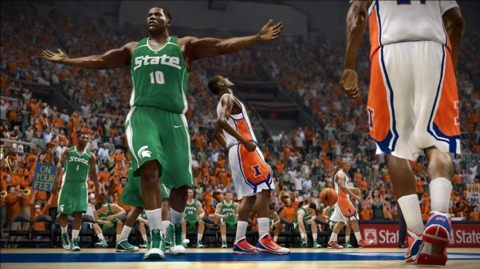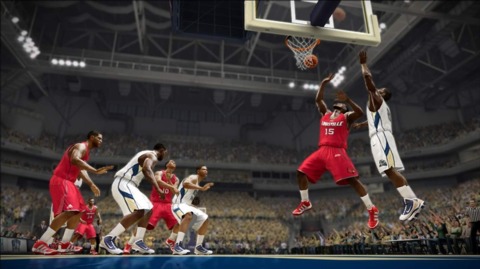NCAA Basketball 10: On the Rise
From the looks of things, there have been two shakeups in the development of EA Sports' upcoming NCAA Basketball 2010: one dealing with the internal workings of the game and antoher revolving around aesthetics. Both look to have their own individual impact on how fans enjoy the game and both...
From the looks of things, there have been two shakeups in the development of EA Sports' upcoming NCAA Basketball 2010: one dealing with the internal workings of the game and antoher revolving around aesthetics. Both look to have their own individual impact on how fans enjoy the game and both complete very necessary goals for the series, which finds itself following a reinvigorated NBA Live franchise after the recent release of NBA Live 10.
The first change is all about the presentation. If you've been following the game closely, you probably know by now about the integration of CBS broadcast graphics and announcers into the game. In addition to the ESPN package, complete with announcers Brad Nessler, Dick Vitale, and Erin Andrews, the CBS presentation style will feature booth announcers Gus Johnson and Bill Raftery (the latter late of 2K Sports' College Hoops series) calling the action. In terms of quantity of commentary, ESPN still has the lion's share of content--the CBS broadcast doesn't have an equivalent of Erin Andrews' sideline reports, for example. Still, from a quality standpoint, the CBS broadcast integration looks just like the games we all watch on Saturdays and Sundays in the winter. And there is no mistaking Johnson's classy play-calling style or Raftery's signature enthusiasm once the tip-off begins.
When playing quick games in NCAA 10, you'll be able to choose between the ESPN or CBS broadcast packages (or set it to random). In Dynasty mode, weekday games will use the ESPN style, while weekend games will use the CBS integration. In addition, certain conferences have exclusive licenses with one broadcaster or the other--for example, the Pac-10 conference championship tournament will use the ESPN license. Finally, once the NCAA Championship Tournament rolls around in your dynasty, you'll see a special tournament-only CBS-style broadcast package that will be used for those games. In all, the addition of CBS integration closes a presentation gap that the series had been lacking for years.
New graphics packages and announcing teams are fun, but of course they aren't the only things the team worked on with NCAA 10. Both NBA Live and NCAA Basketball share a central gameplay team that creates the core mechanics for both games. But, as line producer Connor Dougan told me, because NCAA is released a few months after Live's ship date, they use that extra time to polish things and to add gameplay features that are more in line with the way the college game is played.
The best example of that collegiate approach in NCAA 10 is the introduction of motion offenses to the game. Essentially a streamlined formation and play-calling system, the motion offense system effectively accomplishes a couple of things. First, it shows teams using a wide variety of formations on the floor, ones that run closely, if not identically, to what that team will run this season in real life. Secondly, and more importantly for casual fans, using the motion offense system is simple and effective.
There are eight basic motion offense formations in the game: Princeton, dribble drive, 4-out, 5-out, Flex, 3 out 2 in, triangle, and zone motion. Each features a different starting base for your players on the floor, and each has its specific strengths and weakness. For example, the 5-out features all of your players--even your big men--in the perimeter and is ideal for teams with good shooters at every position. The Princeton, on the other hand, features players starting in the high post and is often characterized by players trying to open up backdoor opportunities to the rim. You're not tied to any specific formation for your team, and if you're particular about things, you can even choose the types of plays available to you when running a specific formation.
Interestingly, the game doesn't even refer to you "running plays" in this system. Instead, by tapping the left bumper when your players are in position on the offensive side of the floor, you're calling for players to start moving around the floor and get open. Of course, underneath, the AI's gears are turning, as players look for spots to get open or streak to the basket. Unless you're calling a specific play (which you can do by pressing the right bumper and scrolling through a list), however, making something happen on the floor is just a matter of a simple tap of the button.
What play is called is dependent on several factors--the formation, the player holding the ball and his position on the floor, and what the defense is doing at that moment. Each time you look to create motion, you'll have a primary player to throw to (indicated by the Y icon over his head) and, in some cases, an option receiver (indicated by the B button). Of course, you're never required to actually run the play you just called--you can instead simply throw the ball to another player on the court using the A button and the right stick.
In fact, when playing against a friend, play-calling can become a bit of a cat-and-mouse game; the Y or B icons over players' heads are a sure sign that your opponent has called a motion play. Because of that, it's easy to key in on one of the possible pass recipients--cagey players will sometimes call motion plays they have no intention of running just to throw their opponent off guard, perhaps creating an unwitting double team on defense that the offense can then exploit.
Having played nearly a full game during my demo time with NCAA 10, it's clear to me that the motion offense stuff is a fun addition to the game. I played one half using the Michigan Wolverines, running the 5-out formation. With so many players near the perimeter, and thus spreading out the defense, it was awfully tempting to try to take advantage of some of those lanes and score inside. Still, when that wasn't working, it was easy to kick it out to someone beyond the arc and drain threes or long twos with the Michigan squad that seems to be full of good shooters. Indeed, calling motion plays in NCAA doesn't require you to get to any specific spot for a play to succeed--you can call it anywhere and things will happen on the floor. Running a play isn't a guarantee of success, but it can create opportunities that you probably wouldn't find playing Lone Wolf on the hardwood.
The new focus on offense works in addition to the tempo system that was found in previous versions of NCAA 10--Dougan told me that the tempo feature has been tweaked a bit and these changes will be most noticeable toward the end of the game, when many games slow down considerably. As Dougan put it, it wouldn't make sense for your team to be consistently looking to run an up-tempo pace when you're often looking to kill the clock. Another change to the game: Your coach will be giving more effective advice from the sidelines than simply telling you to block out when rebounding. Instead, he'll praise you for running plays effectively and encourage you to spread the ball around if you're taking too many shots with one player.
The NCAA 10 developers have been working hard to get lots of little visual details into the game--from the black socks the Wolverine players wear, to the addition of Lucas Oil Stadium (home of the Indianapolis Colts and host of the 2010 NCAA Men's Basketball Final Four). Borrowing the Lucas Oil Stadium model from the Madden NFL team at EA Tiburon, the developers of NCAA Basketball repurposed the venue for basketball use, relit it completely, and then focused on making sure the game ran at 60fps when playing there--a considerable challenge considering the sheer size of the crowd the building holds.
The updated presentation options and the new offensive system look like successful additions to NCAA Basketball 10. When I asked about other modes in NCAA Basketball 10, EA Sports folks were mum, which makes me think there are still some announcements to be made for the game. We'll be following those announcements and everything else on NCAA Basketball 10 in the coming weeks leading up to its release on November 17.
Check out these gameplay videos from NCAA Basketball 10:
Got a news tip or want to contact us directly? Email news@gamespot.com



Join the conversation